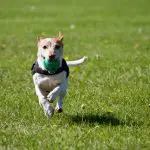5 steps to stop your dogs destructive chewing
5 Steps to Stop Your Dog’s Destructive Chewing
Lets face it, dogs love to chew things. They’ve got a mouth full of teeth and they’re not afraid to use them. Dogs, by nature, have a desire to chew. They use chewing as a way of passing the time, or for just plain fun. They also use it as an outlet for nervous energy, especially if they are not getting enough exercise and being walked properly. If your dog chews thing that don’t belong to him you need to take steps to change that. You have the power to mak sure your dog does not chew your stuff. All it takes is a little effort in training, and establishing yourself as the pack leader. Try taking these five steps:
1. Make sure you dog proof your house, particularly while your dog is still learning the correct behavior. No reason to confuse your dog by leaving your stuff lying around where he can’t help but notice it, then he’s got to sniff it, and before you know it its in his mouth. Remember, dogs don’t rely very much on eyesite. They like to examine everything with they’re nose first, then they’re mouth. What better way to find out what it is than to taste it? When dog proofing your house you will need to move anything you don’t want your dog chewing to somewhere that your dog cannot get it. Don’t forget that your dog is pretty agile and can get to a lot of places you might not think he could. Make sure to keep your clothes in drawers, closets or hampers. Especially shoes. Other prime targets for K-9 larsony include garbage cans, and small electronics like cell phones and remote controls and eyeglasses. I hope I don’t have to tell you to keep your food under lock and key (this goes double if you have kids!)
2. Keep in mind the fact that the more your dog chews outlawed objects the more apt he will be to keep doing it. This most likely will mean keeping your dog confined to a completely dog proofed area when you are not around until you are confident that he knows the rules of the house.
3. Always have lots of treats for your dog to have fun with. If he is enjoying his own stuff he will have less reason to turn his greedy nose toward your stuff. If, on the other hand, there is nothing interesting of his…
Get yourself a bunch of toys from your local pet store. Five or six should do. Then you want to give your dog two or three to play with at a time. Once a week, or so, swap out a toy with one from your reserve. Couple that with a new bone every once in a while and you cut down your dog’s need to chew on your stuff to a bare minimum.
4. When choosing a toy for your dog to chew on it is important not to give him normal household objects to chew on. If you give your dog an old towel, or a discarded shoe, he will think it is okay to chew on towels and shoes. How is he supposed to know that one is fine to chew on and the other not? Try to only give your dog chew toys and bones that are specified dog treats. Be sure to consult your veteranarian before giving bones to your dog, since only certain types are good for the dog. Some bones, however, are excellent for your dog’s teeth!
5. Spend a lot of time with your dog in the “chewing areas”. Don’t keep the dog in a dog proofed area until its time to go out, or eat. Actively supervising your dog in the problem areas is the only way to teach him. When you do catch your dog chewing something of yours let him know its wrong. Clap your hands or make a short loud noise, then get the object away from the dog. Next you should immediately give him one of his own treats and give him some hearty praise for chewing it. The trick is to make your dog associate chewing his toys with getting good attention and back scratches, but chewing your stuff with loud annoying noises.
Applying these five steps will help you and your dog to stop destructive chewing, but you must remember to be patient. Your dog will not know what you want at first, but he will learn with time. The most important things are to spend a lot of time with your dog, establish a good relationship where you are the pack leader, and not give him mixed signals as to what you want. The more time you spend with him the faster he will learn. In the meantime remember step number one… Dog proof your house!


